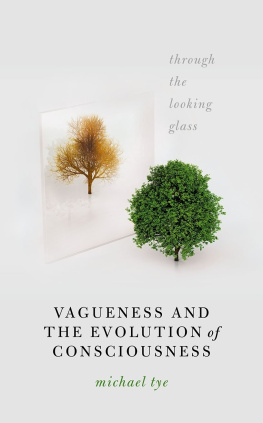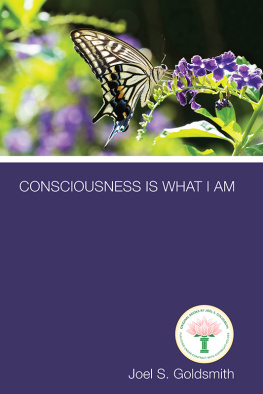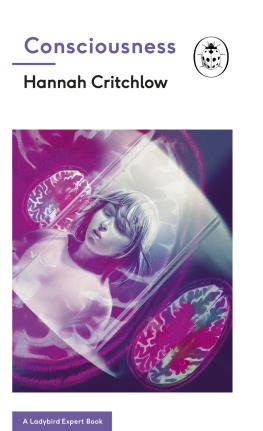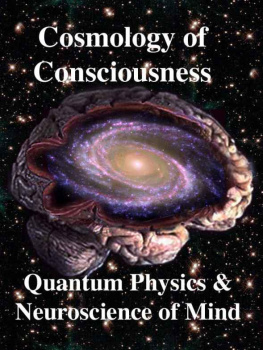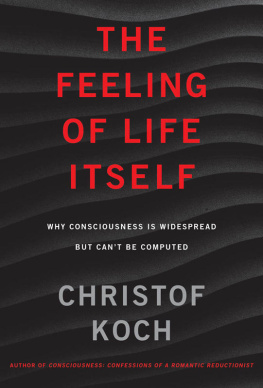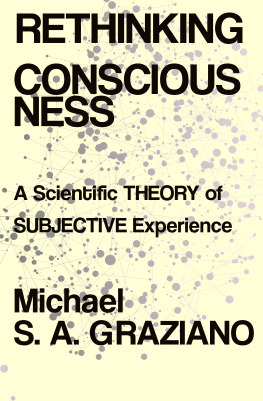Vagueness and the Evolution of Consciousness

Great Clarendon Street, Oxford, OX2 6DP, United Kingdom
Oxford University Press is a department of the University of Oxford. It furthers the Universitys objective of excellence in research, scholarship, and education by publishing worldwide. Oxford is a registered trade mark of Oxford University Press in the UK and in certain other countries
Michael Tye 2021
The moral rights of the author have been asserted
First Edition published in 2021
Impression: 1
All rights reserved. No part of this publication may be reproduced, stored in a retrieval system, or transmitted, in any form or by any means, without the prior permission in writing of Oxford University Press, or as expressly permitted by law, by licence or under terms agreed with the appropriate reprographics rights organization. Enquiries concerning reproduction outside the scope of the above should be sent to the Rights Department, Oxford University Press, at the address above
You must not circulate this work in any other form and you must impose this same condition on any acquirer
Published in the United States of America by Oxford University Press
198 Madison Avenue, New York, NY 10016, United States of America
British Library Cataloguing in Publication Data
Data available
Library of Congress Control Number: 2021937352
ISBN 9780198867234
ebook ISBN 9780192637062
DOI: 10.1093/oso/9780198867234.001.0001
Printed and bound in the UK by
TJ Books Limited
Links to third party websites are provided by Oxford in good faith and for information only. Oxford disclaims any responsibility for the materials contained in any third party website referenced in this work.
Contents
As you may recall, when Alice stepped through the mirror, she encountered a very peculiar world in which many of the people she met were chess pieces or characters from nursery rhymes. Everything was inside out, upside down. So it is with consciousness.
Reflection upon the appearance of consciousness in living beings suggests that there are just two alternative views. Either consciousness appeared suddenly so that its appearance is like that of a light switch being turned on or it arose through intermediate stages, not yet definitely involving consciousness but also not definitely not involving it. On the former view, consciousness is an on/off matter, but once it arose, it became richer and richer through time rather as a beam of light may become brighter and broader in its sweep. On the latter view, consciousness is not an on/off matter. There are shades of gray. There is no one moment at which consciousness appeared. It arose gradually just as life did, becoming richer through time as animal brains became more complex.
The latter view seems more plausible at first glance; for if consciousness suddenly appeared out of the blue, as it were, then what was responsible for its sudden emergence? Presumably the occurrence of some suitable neural state. But neurological states themselves admit of borderline cases, so the relevant neural state cannot itself have arisen suddenly. Instead it must have appeared gradually through various intermediate neurological stages. So, if consciousness originally appeared suddenly without any borderline cases, it cannot be identified with any such neurological state; nor for similar reasons can it be identified with any complex functional or informational state supported by the neurological architecture. It seems, then, that if consciousness appeared suddenly, it must be something special and new, totally different from the physical properties of the underlying neural and functional architecture. But if this is the case, what could consciousness be? It appears that we are driven to think of consciousness as something nonphysical in nature that suddenly emerged in certain animal brains without any further explanation. This is very hard to accept.
On the other hand, if consciousness arose gradually then we should be able to describe borderline cases of consciousness just as we can for life. Unfortunately, as I shall argue, that we cannot do. Putative borderline cases of consciousness are all cases in which there is indeterminacy in what is experienced, and not in experience or consciousness itself. So, a kind of paradox arises. Consciousness cannot be sharp or precise, but equally it cannot be vague.
The paradox is laid out fully in the first chapter. One possible response to this paradox is to say that it is based on a mistaken assumption about the origins of conscious states. Conscious states did not arise with neurological complexity. Instead, they are fundamental features of microphysical reality (panpsychism) or at least they are grounded in such fundamental features. lays out the standard version of this view: Russellian Monism. I argue that the view, in either of its two standard elaborations, faces overpowering objections.
In the next two chapters, I discuss the relationship between conscious states and consciousness itself. I argue that the basic tenet of the representationalist view of conscious states can be preserved within a framework that takes consciousness itself, or rather a central element of consciousness I call consciousness*, to be sharp but conscious states vague. Consciousness*, I claim, is indeed a fundamental feature of micro-reality, and thus it did not evolve, but conscious states are not. Conscious states evolved gradually, as did life, through a range of borderline cases. The view with which I end up presents novel solutions to three important problems (the problem of undirected consciousness, the problem of combination, and the problem of tiny, psychological subjects). It also takes up the question of how consciousness can be causally efficacious with respect to animal behavior.
That I am prepared to embrace a position that has something in common with the panpsychist world view will come as a surprise to many, given my past writings on consciousness, but as John Perry quipped: If you think about consciousness long enough, you either become a panpsychist or you go into administration, and I havent gone into administration. I cannot say that the transition has been an easy one. But, to repeat, I am still a representationalist about consciousness. I am also still a physicalist. And it is consciousness*, not consciousness, I maintain, that is to be found in the micro-realm. So, the change is not quite as radical or dramatic as it may first seem.
turns to the question of where in the brain macro-consciousness is located and which animal brains so evolved as to support conscious states. It is suggested here that even though conscious states appeared gradually, on the account I am offering, it may well be true that in human brains and those of many other species, there is a trigger for conscious states that typically (though not always) turns such states on or off and so functions in the same general way as a light switch.
The world is a strange place, if you look into it deeply enough, not as far removed from the world Alice encountered through the looking glass as lay people suppose. We know that already from theories in physics which tell us that microphysical entities are both waves and particles, that there can be action at a huge distance (one so great that there cannot a causal connection, as in quantum entanglement), and that time is dependent on a frame of reference. Perhaps it is only fitting that consciousness should turn out to be strange too.

